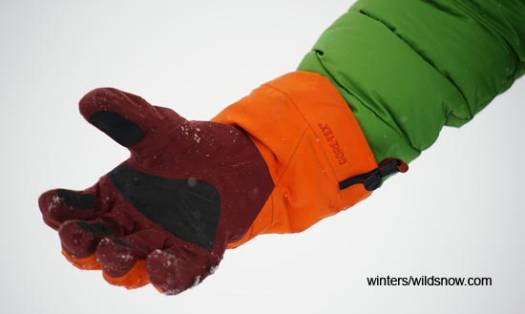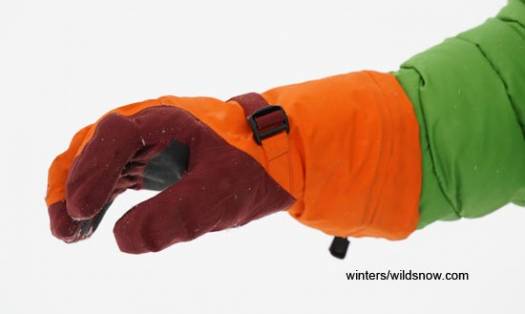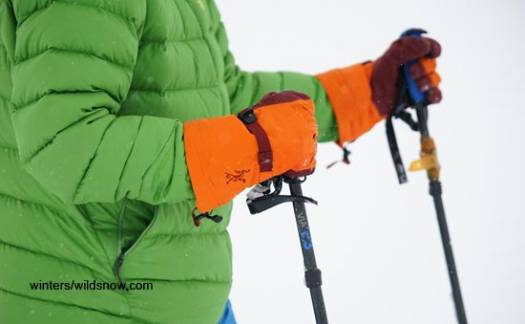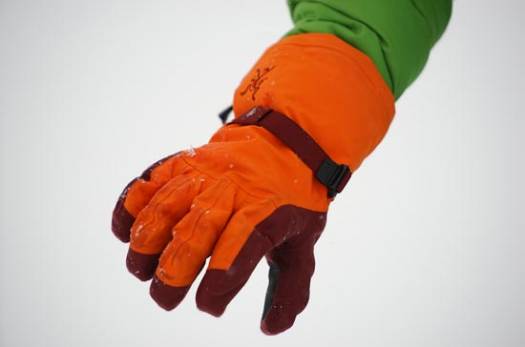(Editor’s note: The author wrote this review while at glacier camp in Alaska this spring. It was embargoed until the Lithic began retail, hence the post title.)
A few years ago Arc’teryx began constructing gloves. Their initial offerings were fairly traditional leather-palmed gloves, albeit with typical Arc’teryx build quality and attention to detail (with a correspondingly high price). I had not tried any of their handwear until their new Lithic glove.
As opposed to Arc’teryx’s first gloves, the Lithics are a radical departure from regular ski and mountaineering glove design. In place of the traditional leather palm, they utilize a burly Gore-Tex fabric. The textile is apparently typically used in waterproof-breathable motorcycle jackets, and is similar in strength to Cordura or backpack fabric. That means that they are the first warm gloves (to my knowledge, commenters at the ready!) that are entirely waterproof breathable, even in the palm. The textile palm also makes the gloves quite lightweight.

The Gore-Tex palm of Arc’teryx Lithic. The burgundy fabric is the burly high-denier fabric, while the orange fabric is lighter weight Gore-Tex. The black patches are laminated reinforcement patches.

The gloves are sewn into a nice “pre-curved” ergonomic shape. This is approximately the shape of the gloves at rest.
Gloves are one of the many gear categories that I think could stand substantial improvement. When it’s cold out, it’s often a struggle to maintain warm hands, and if it’s wet, keeping your gloves dry in many cases is basically a lost cause. Unfortunately many of the issues with gloves are difficult to solve, so it is nice to see solid innovation on Arc’teryx’s part.
Besides the Gore-Tex palm, Lithic gloves incorporate other excellent features. They are sewn into an ergonomic “pre-curved” shape, which makes them quite comfy, and they feel more dextrous than they would otherwise. The gloves are insulated with fleece on the palm, thin Primaloft on the top of the hand, and Primaloft in the gauntlet. Pretty standard. The gauntlet on the gloves is nice and big, with a one-handed adjustable drawcord. They also have a removable wrist-loop cord, a nice touch that I think all gloves should incorporate.
I got the gloves a few months ago and have been using them throughout the winter. They’ve been in my pack or on my hands on almost all my ski days from the PNW, to Japan, and finally out to Glacier Bay, Alaska where we spent a few weeks digging out our tent on a glacier. Excellent glove testing.
The gloves have turned out to be perfect for wet, warm PNW skiing. Makes sense, since they are designed up in Vancouver. They aren’t super warm, but are incredibly waterproof, and also breathe well. They definitely seem to soak through slower than other comparable gloves.
Along with wet testing, I’ve used the gloves in colder climates, mainly Japan and Alaska. They work well during pleasant colder days, but in really cold temps, they definitely don’t have the warmth of a thicker pair of gloves.
Compared to my other favorite gloves, Black Diamond Guide Gloves, the Lithics are significantly less warm, more waterproof, and less durable. I still often carry the Guides, especially on colder days or in colder places. The pairing of the Lithic gloves and the Guides makes a great combo that covers a wide variety of temperatures and conditions. The Lithics are perhaps more similar in warmth to standard Kinco insulated leather work gloves. Although similar in warmth (perhaps slightly warmer), the Lithics blow leather gloves out of the water when it comes to breathability and water resistance. Leather gloves take forever to dry out as well, while the Lithics dry out incredibly quickly.
I’ve only been able to use the gloves for about four months, so I haven’t been able to give them a complete durability test. But they have held up ok so far for backcountry ski touring, again with the caveat that these are not leather palm gloves. The only wear that I can see is some fuzziness on the tips of the fingers, and a few tiny spots where the black reinforcements have started to wear a bit to show the Gore-Tex underneath. My overall sense while observing wear is they won’t hold up nearly as well as a leather-palmed glove. However, that may be just the trade-off that has to be made for a lightweight, fully waterproof-breathable glove.
Another issue is the gloves don’t have a removable liner. Almost all waterproof gloves could benefit from a removable liner; it makes them easier and quicker to dry, and makes the gloves more versatile. This could be a deal breaker for those of you who really really need to dry a moist pair of gloves quickly, so take note.
An additional benefit that I really enjoy is the Lithic’s light weight and pack-ability. They crunch down quite small, less than half the size of the competition.
Overall, I’ve been quite impressed with the Lithic gloves. I was curious whether the extra breathability would be noticeable during normal backcountry skiing use. They breathe better than other comparable gloves and are more waterproof as well, especially compared to gloves that incorporate leather. I find myself using them often, and haven’t found any major problems. They’re especially well-suited to PNW skiing, an environment that’s traditionally hard to find gloves for.
To sum up: Agile, waterproof, packable — with a question about durability as compared to leather and a non-removable liner.
Louie Dawson earned his Bachelor Degree in Industrial Design from Western Washington University in 2014. When he’s not skiing Mount Baker or somewhere equally as snowy, he’s thinking about new products to make ski mountaineering more fun and safe.


